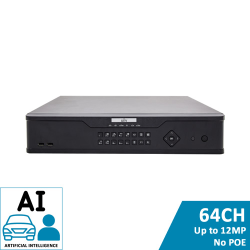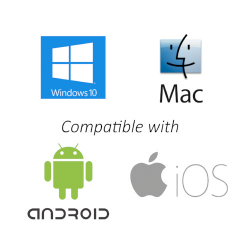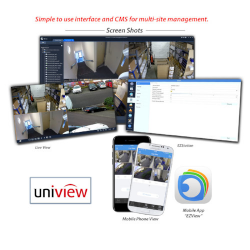UNV Professional NVR (64 Channel, RAID)
Part of the UNV professional range, this IP NVR (Network Video Recorder) has HD recording and playback of all channels. It includes a user-friendly mouse-driven interface with full remote network and mobile phone access. The NVR can auto-detect ONVIF compatible IP cameras; it can support up to 8MP (4K) IP and 12MP cameras. This NVR can also support RAID across the hard drives.
- 64 Channel Video & Audio
- Plug & Play for UNV Cameras
- Supports up to 12MP IP Cameras
- Bandwidth IN: 384Mbps, OUT: 384Mbps
- 2HDMI, VGA & SPOT Output
- VCA with Compatible Cameras (see Special Features)
- ONVIF Compliance (Profiles S, G, T)
- Supports H.264, H.265 or Ultra H.265
- ANR Technology to Enhance Storage (see Special Features)
- Supports RAID 0, 1, 5, 6 and 10
- Fisheye dewarping
- Support N+1 Hot spare
- Support for 12V Power output
- Alarm 16 In, 4 Out, Two-way Audio
- Mac Compatible
- Supplied with Rack Mounts
- Compatible with Sentinel and Immix Remote Monitoring
*NVR purchased without HDD comes with a Limited Warranty. Also, Uniview compatible HDD must be used
Video/Audio Input
Video/Audio Output
Hard Disk
Network
Storage and Backup
General
Application
Interface
This recorder has the following special features:
AI (Artificial Intelligence)
AI allows the NVR to work out if the movement detected was caused by a human, vehicle, or nature. This requires an AI compatible camera (order code ending in -I0).
ANR (Automatic Network Replenishment)
ANR is a feature which allows a camera to record to an onboard MicroSD card, if it loses connection with the NVR. Once the connection has been re-established, the footage is transferred to the NVR. This feature requires ANR support from the camera and NVR.
Fisheye Dewarping
Dewarping is a feature which allows an NVR to dewarp the 360° image from a fisheye camera. This makes the image much more usable as the image is flattened and not warped.
LPR (License Plate Recognition)
LPR is the ability to automatically analyse video to detect vehicles and number plates. This allows the NVR to record footage as normal, but also record and store license plates. This is done using the Uniview LPR camera (HC121@TCR-08S-Z).
N+1 Hot Spare
To use the Hot Spare feature, you must have 1 additional NVR to your total quantity of NVR's. If a live NVR loses network connection or fails for any reason, the hot spare NVR will take over to ensure data integrity and reliability. When the failed NVR comes back online, the hot spare NVR will send the recorded data back to the original NVR, and then will revert back to Hot Spare mode.
RAID (Redundant Array of Independent Disks)
RAID is a data storage technology that combines multiple hard drives into one or more logical units. The purposes of this are data redundancy, performance improvement, or both. This NVR can perform the following different configurations of RAID:
- RAID 0 - Combining all hard drives into one "logical" drive. This configuration gives higher speed, the most amount of usable space, but with no redundancy. If one drive fails, all the data will be lost.
- RAID 1 - Data is written to each hard drive, creating a "mirrored" set of drives. This configuration provides the least amount of usable space, but with redundancy. If one drive fails, no data is lost.
- RAID 5 - This requires at least 3 hard drives to work. This configuration provides a medium amount of usable space, with redundancy. If one drive fails, the unit will assess the missing data and rebuild it. Any more than one failed drive (at any one time) will result in total loss of data.
- RAID 6 - This requires at least 4 hard drives to work. This configuration provides less usable space than RAID 5, but with more redundancy. If two drives fail, the unit will assess the lost data, and rebuild it. Any more than two failed drives (at any one time) will result in total loss of data.
- RAID 10 - This is a combination of RAID 0 and RAID 1. This requires at least 4 hard drives to work. This configuration provides high speed, a medium amount of usable space, with redundancy. If one drive per RAID 1 fails, the unit will assess the missing data and rebuild it. Any more than one failed drive per RAID 1 (at any one time) will result in total loss of data.
VCA (Video Content Analysis)
VCA is the ability to automatically analyse video to detect temporal and spatial events. The feature requires VCA support from the camera and NVR. This NVR has the capability to do the following:
- Audio Detection - Detect a sudden increase or decrease in sound
- Auto Tracking - Tracking a specific target until it is out of range
- Enter Area - Entering into a pre-defined virtual region
- Fire Detection - Detects fire (requires a thermal camera)
- Intrusion Detection - Entering and loitering in a pre-defined virtual region
- Leave Area - Leaving a pre-defined virtual region
- Line Crossing - Detect when a pre-defined virtual line has been crossed
- Motion Detection - Movement within a pre-defined virtual region
- Object Left Behind - Detect when an object has been left inside a region, which wasn't there before
- Object Removed - Detect when an object has been removed from a region, which was there before
- Scene Change - Detect when the scene changed
- Smoking Detection - Detects smoking (requires a thermal camera)
- Tamper Identification - Detect when the camera has been physically tampered with







